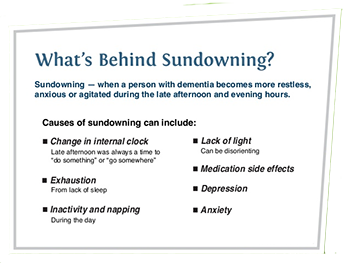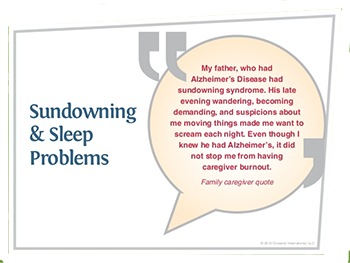
Like us on Follow Us on
Follow Us on  Caregiver Blog
Caregiver Blog![]()
Sundowning Challenges (Part A)
See Also ... More Sundowning Challenges (Part B)
Sundowning symptoms are challenging to manage
Someone with Alzheimer’s or dementia may become more agitated or anxious starting in the late afternoon and lasting through the evening.
They could become aggressive, delusional, paranoid, want to walk, or accidentally wander away. Some may have disrupted sleep schedules or restlessness at night.
This behavior is called dementia sundowning because it typically begins around sundown – late afternoon or evening.
These dementia sundowning symptoms are challenging for you to manage. They are disruptive and difficult to manage. They’re stressful and negatively affect your older adult’s quality of life.
Sundowning symptoms
When someone is sundowning, they may be:
** Agitated, upset, or anxious
** Confused or disoriented
** Restless
** Irritable or demanding
** Suspicious
They might show it by:
** Getting angry or yelling
** Pacing the room
** Seeing or hearing things that aren’t there
** Having mood swings


What is sundowning and what causes it to happen?
Because this behavior tends to happen in the late afternoon or evening, it’s often called “sundowning.” Some studies say that sundowning affects up to 20% of people with Alzheimer’s. And, it can also affect older people who don’t have dementia.
Scientists don’t know exactly why sundowning happens, but think that it’s caused by changes in the brain. Their body clock, which regulates when we’re awake and when we’re asleep, might be affected.
Ways to reduce and manage sundowning symptoms
1. Track their behavior and look for patterns
- To reduce sundowning behavior, the first thing to do is figure out your older adult’s biggest triggers – the things that are most likely causing them to get upset or agitated.
- Use a caregiving notebook to track their behavior and activities. Write down your older adult’s daily routine and any symptoms you notice. Pay special attention in the few hours before their sundowning usually starts.
- After a few days, you’ll be able to spot clues that tell you which activities, environments, or needs are triggering their behavior or making symptoms worse. Knowing their triggers helps you avoid them.
2. Make sure basic needs are taken care of
One or two hours before their symptoms usually start, check to make sure their basic needs are met. Don’t wait for them to ask – they may not be aware enough or able to properly express their needs.
Sundowning is more likely to happen when someone is:
For example, you could make sure they eat a snack and drink some water at 2:30pm, use the toilet every hour or two starting at 3pm, or time their pain medication so it kicks in by 4 or 5pm.
- End-of-day exhaustion (mental and physical)
- Feeling pain or discomfort
- In need of the toilet
- Hungry or thirsty
- Bored
- Depressed
- Too hot or cold
- Having trouble sleeping
3. Minimize noise, distractions, and shadows
- Helping your older adult feel calm and safe will reduce sundowning behavior that’s triggered by overstimulation or fear.
- As daylight fades, shadows or dim lighting can play tricks on their eyes and brains and cause fear or anxiety. Increase feelings of safety by closing curtains and blinds before the sun starts setting so they won’t see reflections or shadows from outside. Turn on plenty of lights to eliminate scary shadows or dark corners
- It’s also important to keep them calm by limiting noise and distractions. For example, turn off the TV, lower music volume, and don’t have visitors over. This is also a time to avoid upsetting or tiring activities like bathing. If there are others in the house, move children to another room and ask people to be very quiet. Also make sure to avoid noisy chores like vacuuming.
4. Be mindful of your own stress level
- After a long day, you might be frustrated, cranky, and exhausted by afternoon (it’s only natural!). Even if it’s not obvious, people with dementia may be able to sense it. They’re often more sensitive to body language and tone of voice.
- Picking up on your stress could cause your older adult to become “sympathetically” stressed, leading to an increase in agitation and anxiety.
- To reduce your own stress, use coping tips like taking mini-breaks during the day, getting regular help, taking a 2 minute stress-relief break 30 minutes before their symptoms usually start, and more.
5. Establish a daily routine
- Sticking to a regular daily routine reduces stress, increases the feeling of security, and improves sleep. All of that helps reduce sundowning symptoms.
- Set regular times for waking up, meals, and going to sleep. Schedule appointments, outings, visitors, and bath time in the earlier part of the day, when they’re likely to feel their best.
6. Create a relaxing environment
- Making your older adult’s environment especially calm and soothing in the later afternoon gives you a head start on reducing agitation and anxiety.
- For example, you could play soft music at low volume or use aromatherapy to lightly scent the room with lavender.
7. Improve nighttime sleep quality
- Having dementia is exhausting, even if your older adult doesn’t do much. That’s why they may want to rest often during the day.
- However, too much daytime napping can make it difficult to sleep through the night, a top challenge for many caregivers. Poor nighttime sleep can also increase daytime fatigue, causing a negative cycle that increases sundowning symptoms.
- Structure their daily routine to minimize afternoon naps. If a nap is needed, make it earlier in the afternoon and keep it brief. Earlier in the day, encourage gentle daily exercise – it’s a great way to improve sleep quality.
- In the evening, limit or avoid stimulants like heavy meals, smoking, caffeine, sugar, chocolate, or alcohol.
- To improve their sleep, you might also try a weighted blanket, white noise machine, aromatherapy, or experimenting to find the most comfortable room temperature.
OUR STORY
A Family Reflection And A Promise Kept
THE CAREGIVER ROLE
What is a Caregiver
The Caregiver Defined
Who Do Caregivers Care For
Accepting the Reality of Dementia
6 Steps to Successful Caregiving
Caregiver's Are Not Alone
Asking For & Getting Help
The Caregiver Code
Rights of a Caregiver
General Suggestions
Unmet Needs Of A Caregiver
Caregiver And Work
Feelings And Caregiver Stress
Questions & Answers
Notable People
STRESS, COPING & FEELINGS
The Caregiver Code
Rights of The Caregiver
Coping With Stress
Feelings And Caregiver Stress
Stages Of Alzheimer's
Helping Children Understand
Caregiver Burnout
Protecting Yourself From Burnout
Making Time For Reflection
Moving On
How is Competency Defined?
Power of Attorney
What is an Advanced Directive?
Do I Really Need a Will or a Trust?
COMMUNICATION
Importance of Communication
Communicating With Someone Who Has Alzheimer's
Your Approach Sets The Tone
Think Before You Speak
Doing Tasks Together
Having Trouble Being Understood
Keeping a Dementia Journal
Making Caregiving Easier - Caregiver Notebook
Things NOT To Do
When It Just Fails
ALZHEIMER'S BASICS
What is Alzheimer's
Why is Alzheimer's Different
Stages of Alzheimers
Can Alzheimers be Inherited
Statistics
The Mortality Question
TIPS AND ISSUES
New To Family Caregiving?
Tips For Dealing with Aggression
Places To Turn For Caregiver Supoort
Take Advantage of Community Support
Random Tips From Other Caregivers
Providing Long Distance Care
When To Stop Driving
Dealing With Family
Conflict
Tips on Sundowning
Ways to Reduce Sundowning Challenges (part A)
Ways to Reduce Sundowning Challenges (part B)
Helping Children Understand
Pet & Toy Therapy
Fixations
Getting Someone to Take Medications
Tips For Medical Appointments
Dealing With Resistance
Tips For Day To Day
Intimacy And Sexuality
Visiting A Person With Dementia
Music And Dementia
Tips For Holidays And Gatherings
Art as Home Therapy
PROBLEM SOLVING
What Can I Do To Be A More Effective Caregiver
Planning Tips
Dealing with False Dementia Accusations
Responding to Common Dementia Accusations
Steps to Effective Problem Solving
PROBLEM BEHAVIOURS
Anger
Hallucinations / Paranoia
Incontinence
Bathing
Dressing
Eating
Sleeping
Repetitive Actions
Verbal / Screaming
Wandering
Wanting to 'Go Home'
RESEARCH & DONATIONS












